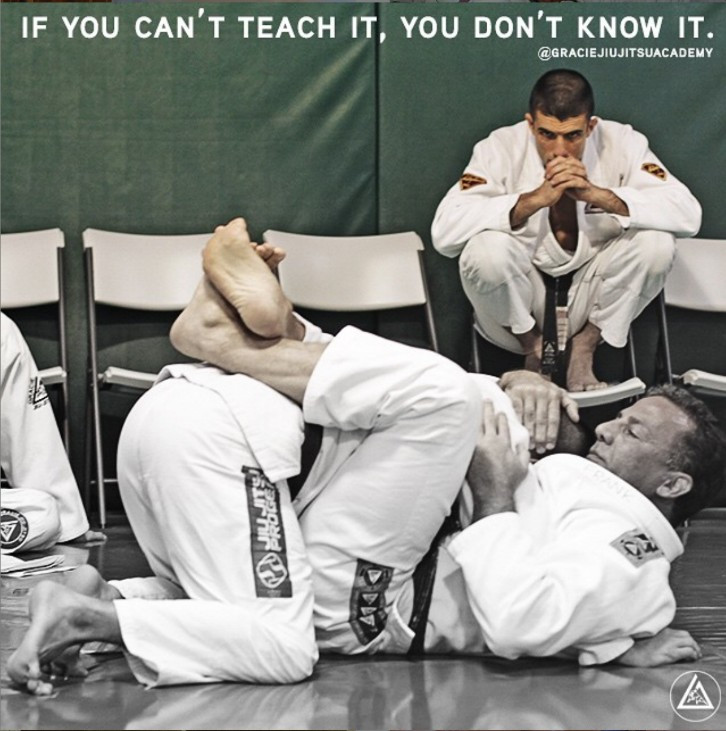Powerful Principles
Even within your first few months of jiu-jitsu training, you’ll likely notice that not everyone progresses at the same pace. This is true even for people who started training at the same gym at the same time, who share the same level of training, the same body type, and have learned from the same instructors. There is no real difference between how strong they are, how fast they are, or how dedicated to jiu-jitsu they are. Still, it’s clear that one fighter feels more at home on the mat than the other.
Ryron and Rener Gracie explain in the below video, this is extremely common, and it can most often be explained by having the right mindset and the right philosophy. Simply put: One fighter is a student of technique. The other is a student of principles.

A Student of Technique
There is nothing wrong with being a student of technique when you are beginning. After all, most people come into the gym for the first time having never been in a fight and with absolutely no training. They need to learn technique and they need help understanding the basic dynamics of a fight. Classes at Gracie University offer students a chance to see these components broken down so they can examine the minute details of moves, and then learn them step by step. This is why so many people who are new to jiu-jitsu really appreciate the Gracie curriculum.
Unfortunately, this level of detail is a double-edged sword. Because the details can be so intensive, some people end up believing that they’re learning all they need to know about jiu-jitsu by simply following these steps. They take what they learn in class and simply try to perfectly replicate it on the mat.

A Student of Principle
Contrary to a student of technique, a student of principle recognizes that what they learn in class, even if it is heavy on details, is only half of what they need to become a great fighter and achieve jiu-jitsu mastery. They understand that the Gracie curriculum is more of a guide than a textbook, and that moves are most effective when they’ve been modified and adapted to respond to a specific situation or a specific opponent.
For example, think of a move like a triangle choke. This is a move where you encircle your opponent’s arm and neck with your legs. Done correctly, your legs lock into a triangle shape, the pressure you exert restricts blood flow from your opponent’s carotid artery to their brain, and your opponent either taps or loses consciousness.
Even if this move is very similar every time you use it, there are always subtle differences in how it’s applied depending on the context of a fight. “I learn it one way,” Rener explains in the clip, “but I’ll use ten different tweaks and variations of that technique in ten different fights against ten different people of ten different shapes.”
In some cases, the differences may be more noticeable. For example, if you’re a smaller person going up against a bigger opponent, you may not be able to fully form a perfect triangle with your legs, thereby meaning it’s not technically possible to complete the choke. Does that mean the move is off limits? Of course not! Even if your legs are not fully locked, if you rely on the principles that make the technique effective, you can still get your opponent to tap.
Learning to Be a Student of Principle
Learning to be a student of principles starts with reading between the lines when you’re learning moves and technique. It means that you’re not just following the steps for each move like you’re putting together a piece of furniture. You understand that there are larger lessons about the dynamics of a fight and that things like leverage, distance control, and the creation of space underlie good technique. These are the principles of jiu-jitsu. As Rener said, “Techniques are the window through which you’re exposed to the principles.”
In many ways it’s similar to how musicians learn their instruments. To a beginner, the chords and the scales are just meaningless notes. Eventually, they become patterns that they recognize. Eventually, the musician comes to see the theory behind the patterns, and to understand the principles of music. This is when they begin to be able to improvise, to write songs, and to really master their instrument.
Coming to understand these principles and modifying moves to fit your own style is not something that your instructor can teach you. It’s something that each fighter has to develop over time as they practice and spar and learn how to iterate and improvise with the move in real-world scenarios and with different fighters. Students of jiu-jitsu need to understand the techniques well enough to become students of principles.
As Rener says, once you become students of principles, “Your jiu-jitsu becomes universal. Remain a student of techniques and your jiu-jitsu will be very limited in its applicability and reliability on the streets.”
